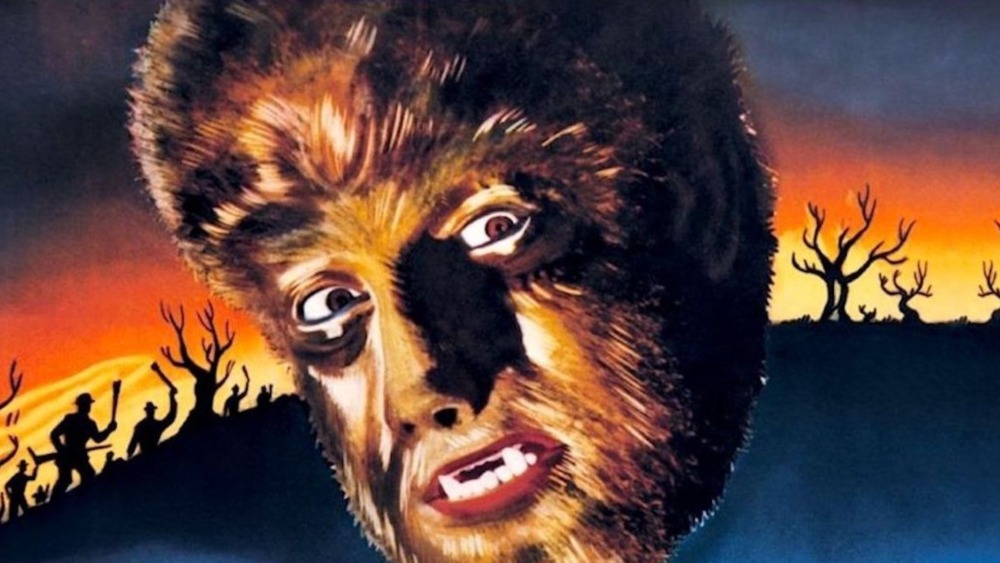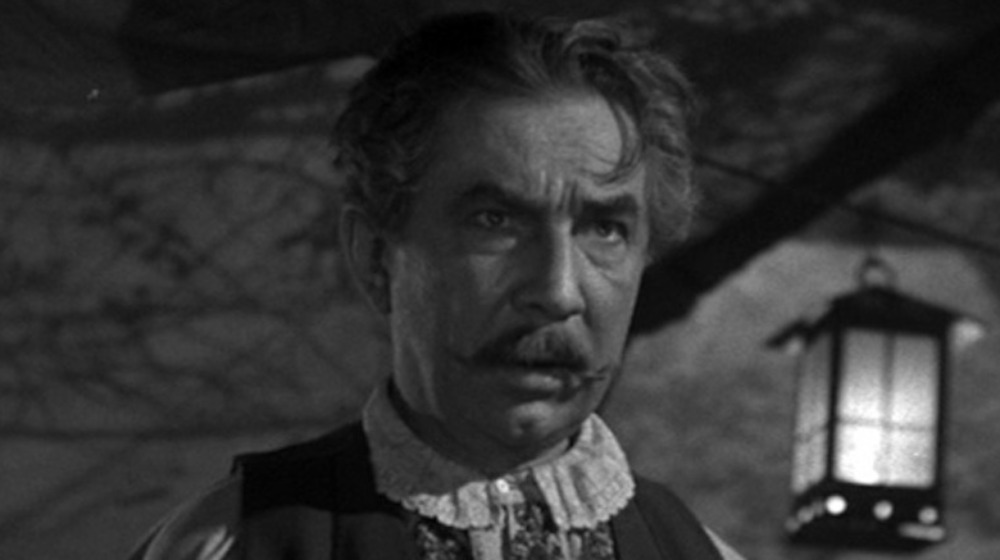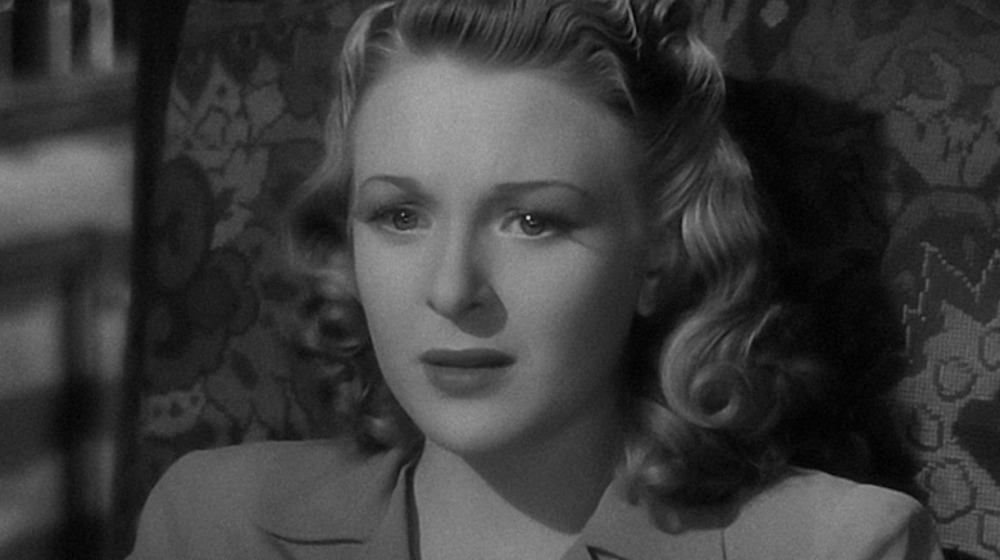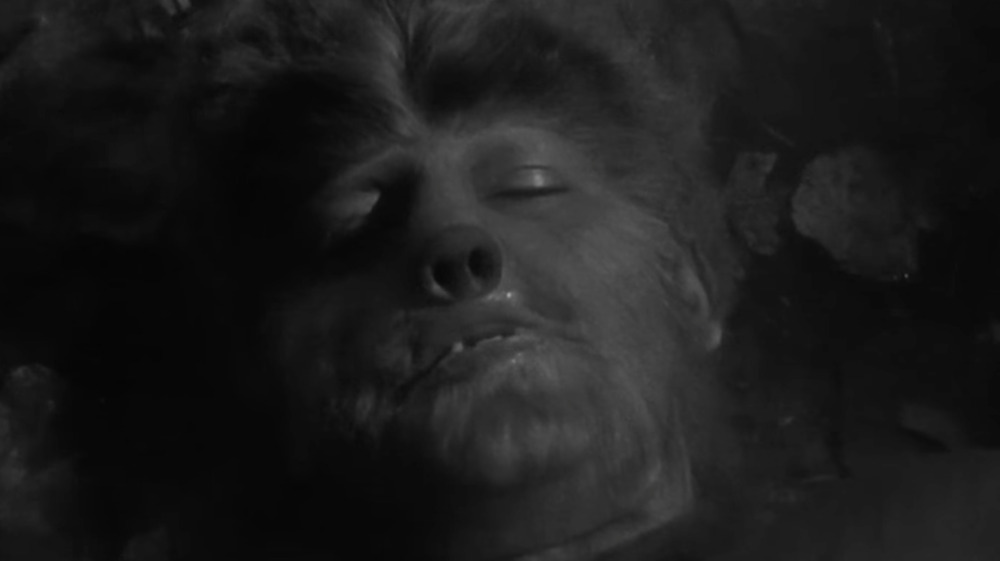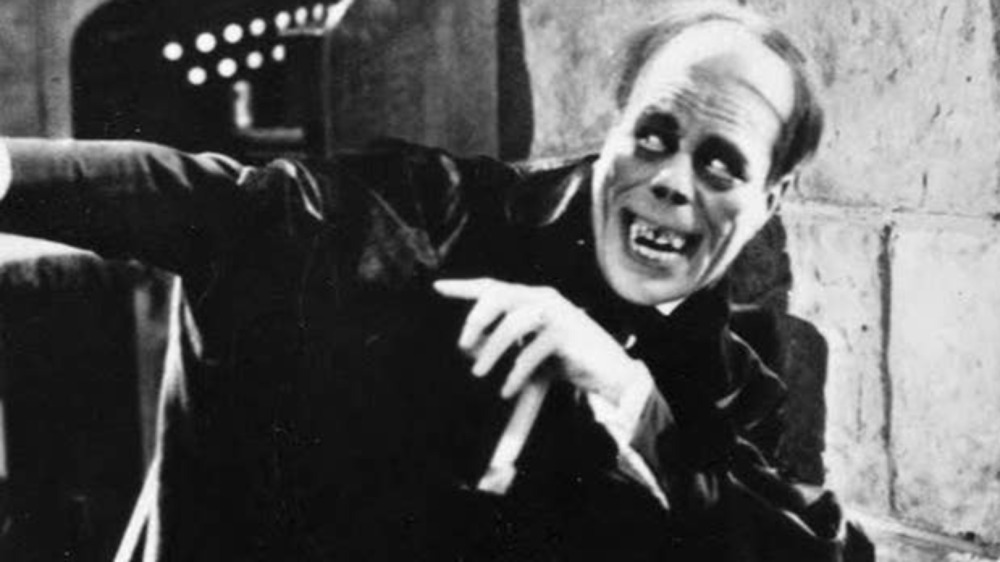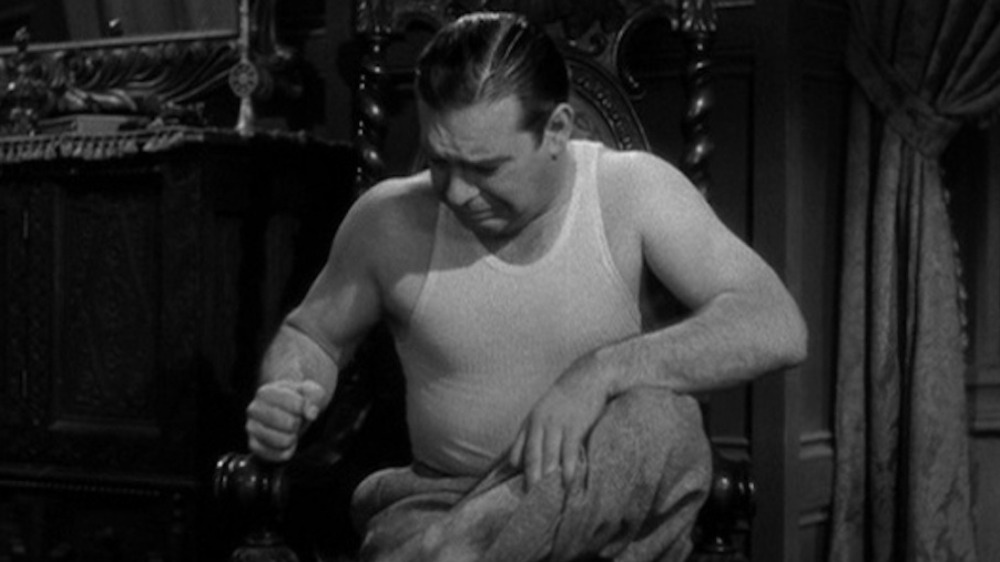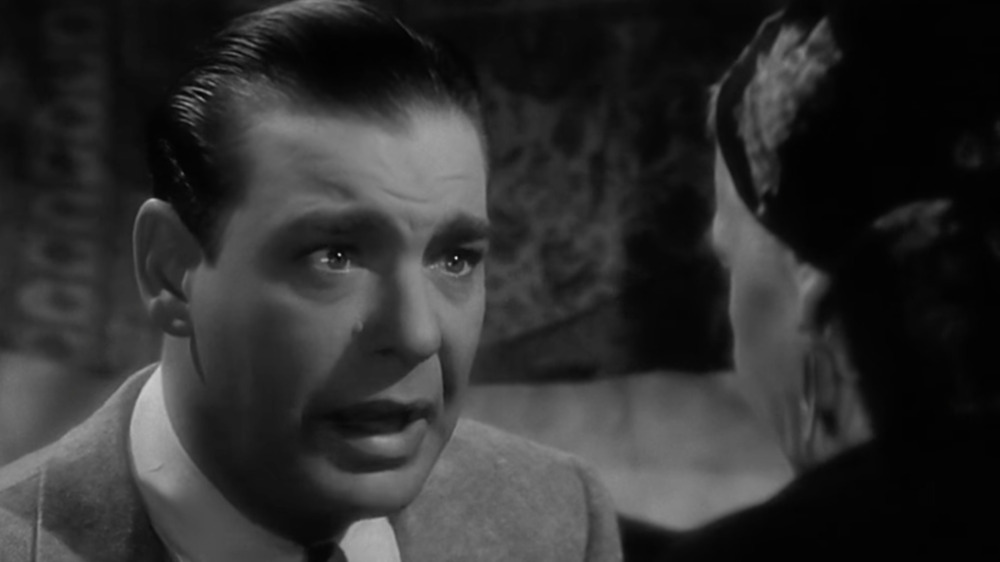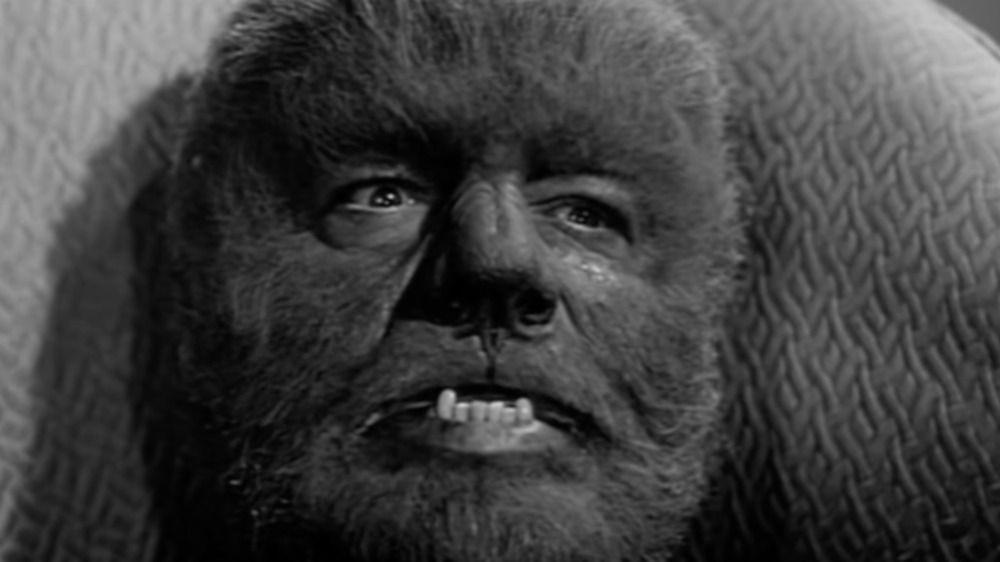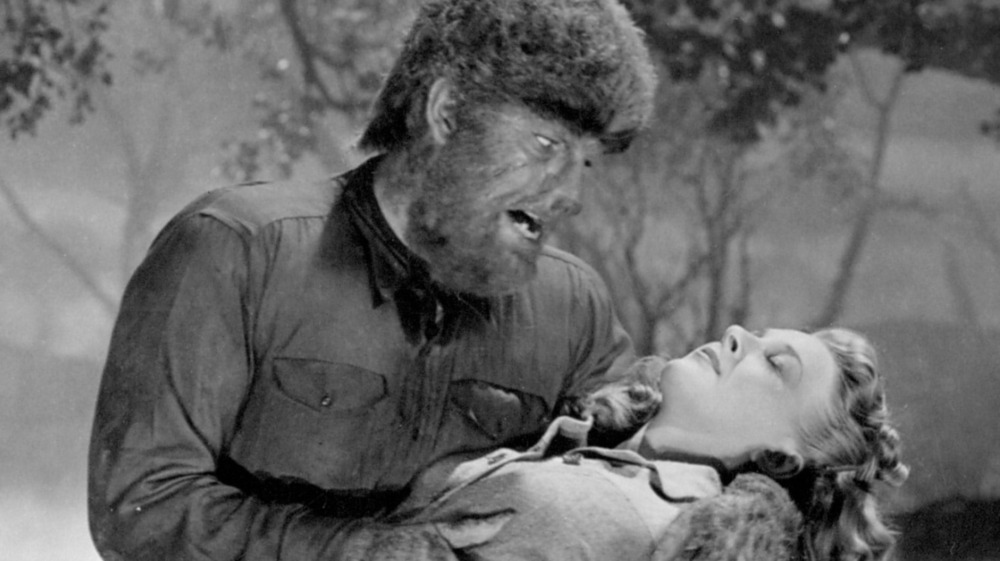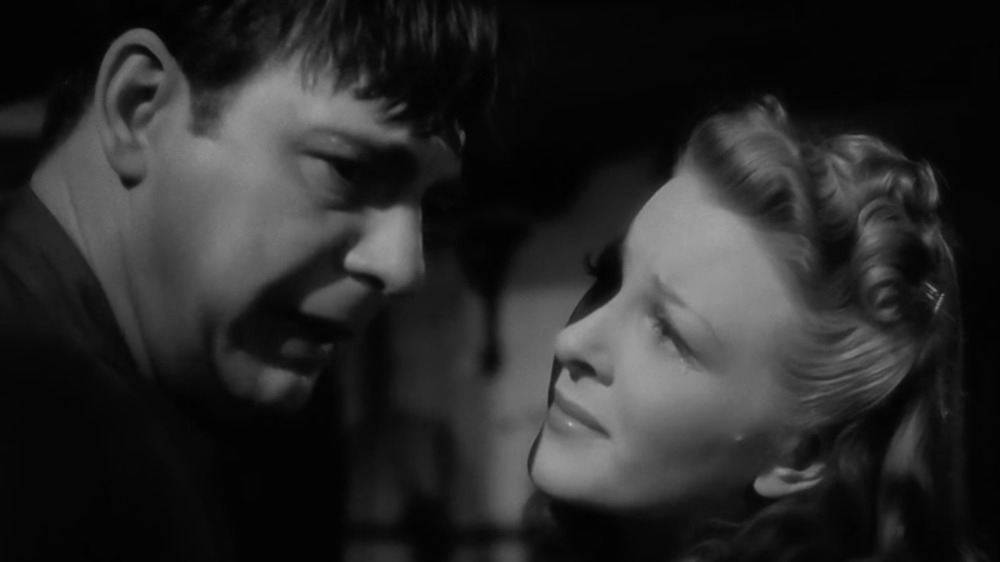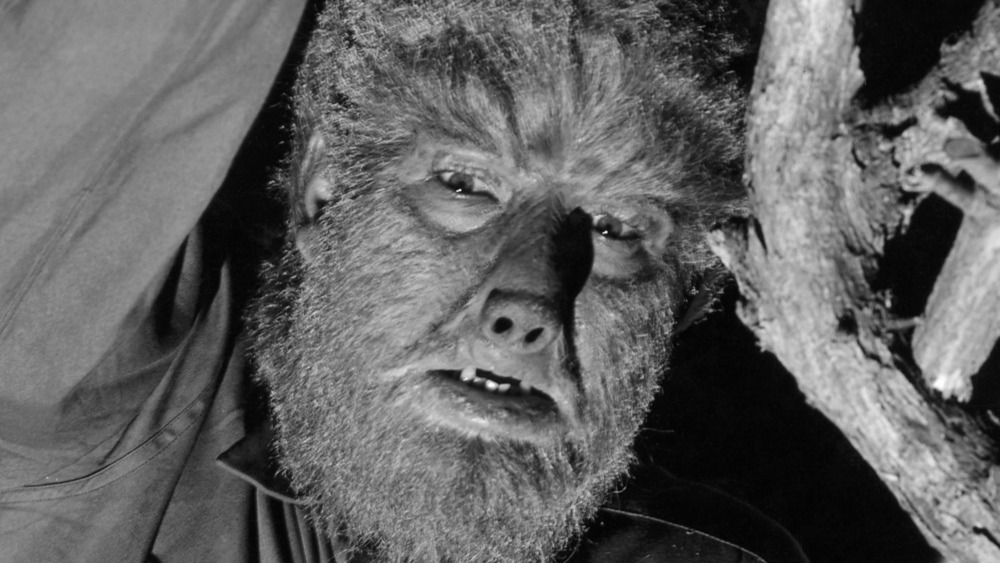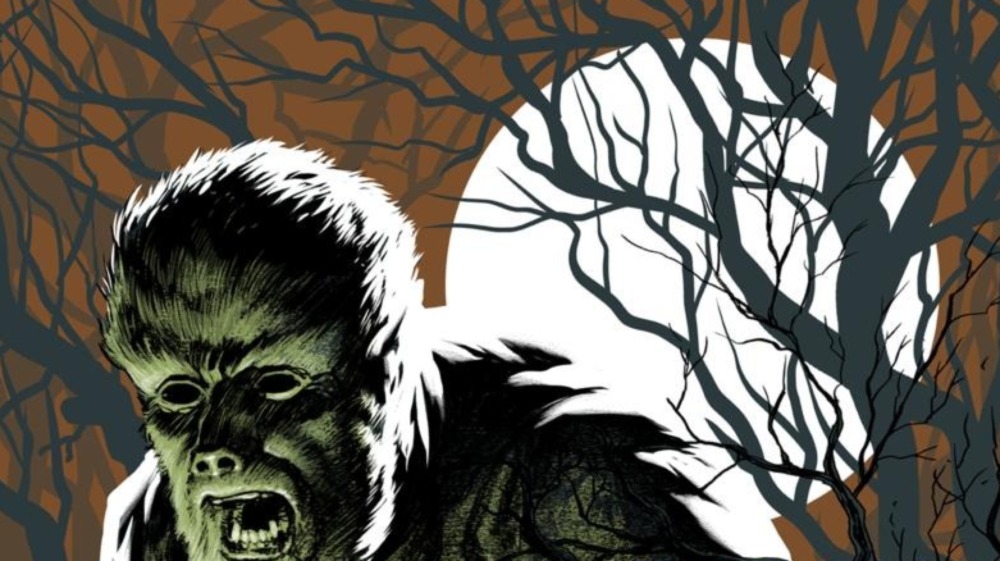The Untold Truth Of Wolf Man's Creators
Among Universal Studios' classic movie monsters, the Wolf Man is unique. Unlike Dracula, Frankenstein, the Invisible Man, and the Phantom of the Opera, The Wolf Man isn't based on a work of classic literature. However, the tragic tale of Larry Talbot (Lon Chaney Jr.) and his endless search to free himself of his werewolf curse is so compelling that it has influenced many popular perceptions of werewolves.
Behind the scenes, the Wolf Man also has many fantastic stories. From the legends surrounding Lon Chaney Jr.'s monster makeup to Chaney's unique acting lineage and the surprising identity of the wolf who cursed Larry Talbot, monster movie buffs know the tales surrounding the creation of the Wolf Man are just as incredible as the monster himself.
Let's take an in-depth look at some of the stranger stories and little-known facts surrounding Universal's best-known lycanthrope.
The original werewolf was also Dracula
The Wolf Man (1941) tells the origin story of Larry Talbot, a Welsh aristocrat who spends many years studying and working in the United States before returning to his ancestral home. Upon falling for beautiful shopkeeper Gwen Conliffe (Evelyn Ankers), Larry accompanies Gwen and her friend Jenny (Fay Helm) to a gypsy camp where they encounter a fortune teller named Bela. Unbeknownst to the group, Bela is secretly a werewolf. He tries to kill Jenny and ends up cursing Larry with the disease of lycanthropy, causing Talbot to change into a werewolf himself.
Bela is played by Bela Lugosi, the Hungarian-American actor most famous for his classic depiction of Count Dracula in the 1931 film Dracula. The movie cemented Lugosi's reputation as a horror icon. He played Dracula twice in Universal films, appearing a second time in the spoof Abbott and Costello Meet Frankenstein (1948). Lugosi went on to play many other iconic horror characters, including Frankenstein's monster in Frankenstein Meets the Wolf Man (1943) (a somewhat less memorable portrayal than that of his rival, Boris Karloff, in 1931's Frankenstein) and the hunchback Ygor in both Son of Frankenstein (1939) and The Ghost of Frankenstein (1942).
The "wolf" that curses the Wolf Man is Lon Chaney Jr.'s pet dog
When the gypsy Bela transforms into a werewolf and goes after Jenny, he doesn't become a hairy, two-legged man-beast like the Wolf Man, but an actual wolf. The filmmakers chose to cast a retired police dog named "Moose" to play the part of the wolf, using heavy fog effects to obscure its identity it attacks Jenny. Larry rushes to the rescue and manages to bludgeon the werewolf to death with his silver-headed cane, but not before the wolf bites him and transfers its curse to him.
Offscreen, Lon Chaney Jr. and Moose had a friendlier relationship. In fact, Chaney liked Moose so much that he took the German shepherd home with him and became his new owner. Moose became Chaney's constant companion when he worked at Universal and appears in many of Chaney's other films, including Frankenstein Meets the Wolf Man (1943). Sadly, Moose died after being hit by a car in 1944 while Chaney was filming another project.
The Wolf Man makeup was originally designed for a different actor
The savage look of the Wolf Man is closely linked to Lon Chaney Jr. Originally, however, the iconic monster makeup was created for a very different actor. In 1935, Universal Studios came out with Werewolf of London, a monster movie starring Broadway actor Henry Hull as Wilfred Glendon, a botanist who gets attacked by a werewolf (Warner Oland) and transforms into one as well.
Legendary monster makeup artist Jack Pierce, who also designed the makeup for Frankenstein's Monster, the Mummy, and others monsters in Universal's horror pantheon, created a werewolf makeup design identical to the one used in The Wolf Man for Werewolf of London. For years, it was rumored that Hull refused to wear Pierce's elaborate design because he didn't want to sit for long hours in the makeup chair — or because he was too vain to have his famous face made unrecognizable by the werewolf makeup.
However, in the book Universal Horrors: The Studio's Classic Films: 1931-1946, Hull's great-nephew, Cortlandt Hull, states that the screenplay called for the werewolf to be recognizable to his wife in the final scenes. Since Pierce's original design would have made Hull too unrecognizable, studio head Carl Laemmle made Pierce design a streamlined version of the makeup. Years later, Pierce recycled his original design for Lon Chaney Jr.'s Wolf Man and got to showcase his iconic version of a Universal werewolf.
The Wolf Man is the son of the "Man of a Thousand Faces"
While he became famous for his stage name "Lon Chaney Jr.," the actor who played the Wolf Man was born Creighton Tull Chaney. The son of actor and makeup artist Lon Chaney, popularly known as "The Man of a Thousand Faces," the younger Chaney had to contend with his father's reputation, earned from memorable appearances in silent films such as The Phantom of the Opera (1925) and The Hunchback of Notre Dame (1923). Eventually, Creighton used the name "Lon Chaney Jr." after his father died in 1930 and got work in Universal monster movies as well as big-budget classic films like High Noon (1952).
While Lon Chaney may be "The Man of a Thousand Faces," Lon Chaney Jr. is mostly known for playing one face; he's the only actor to play the Wolf Man in all of his 1940s films. Still, Chaney eventually played versions of almost all the other Universal monsters, including Frankenstein's monster in The Ghost of Frankenstein (1941), the mummy Kharis in The Mummy's Tomb (1942), and Count Dracula in Son of Dracula (1943), giving him many distinctive visages of his own in the movies.
The makeup allegedly took 16 to 22 hours to apply
Today, werewolf transformations are mostly accomplished through CGI. Even when actors need to wear makeup, modern techniques make the process much easier than what Lon Chaney Jr. had to go through.
According to makeup artist Jack Pierce, it took 2 1/2 hours to apply all the layers of hair, greasepaint, and fangs onto Chaney to transform him into the Wolf Man.
However, many Wolf Man movies show Larry Talbot's face transforming into the Wolf Man onscreen through lap dissolve shots. This meant Pierce had to apply the makeup more slowly to give the camera time to shoot a few frames of footage so the transformation scene could be edited together. Chaney also had to keep perfectly still for all the shots to match up.
Rumor had it that it took 16 to 22 hours for the Wolf Man transformation to be filmed. At least Chaney got to move somewhat during that time. When it came time to put a rubber snout on Chaney, an outline of his head was drawn on a glass plate positioned in front of his face. This allowed Chaney to get up and have more makeup applied in Pierce's lab. He could then be returned to the set and stay still for the rest of the process.
Lon Chaney Jr. claimed he was burned from the makeup process
Lon Chaney Jr. has called his makeup artist, Jack Pierce, "one of the finest makeup men who ever lived." However, his time in Pierce's makeup chair was not usually pleasant.
The "fur" covering the Wolf Man's face and hands was real animal hair, though it came from a yak and not a wolf. To create the look of a beast that was out in the woods, Pierce would curl, singe, and burn the yak hair with a curling iron. However, since the hair had already been applied to Chaney's face, the actor complained that Pierce sometimes burned him with the curling iron — on purpose. Legend had it that the two men almost got into fights.
Still, Pierce would continue to be Chaney's monster makeup artist on several Universal horror films, including The Ghost of Frankenstein (1942), Frankenstein Meets The Wolf Man (1943), and House of Dracula (1945). Despite his later complimentary words, one story states that Lon Chaney Jr. sent Pierce a signed photo with the following message to show how he really felt about him:
"To the greatest goddamned sadist in the world — LC."
Later Wolf Man makeup artists streamlined the process
By 1948, Jack Pierce had lost his job to studio politics and was no longer Lon Chaney Jr.'s makeup artist. Instead, Bud Westmore, Jack Kevan, and Emile LaVigne took over makeup duties when Chaney reprised the role of the Wolf Man for Abbott and Costello Meet Frankenstein (1948).
Westmore favored a simpler approach to both the Wolf Man makeup and the transformation process. Although he retained the same classic look of the Wolf Man, he created mask-like rubber appliances that could be attached directly onto Chaney's face. This differed from Pierce's approach, which built every Wolf Man makeup job from scratch. However, the new Wolf Man makeup was more comfortable for Chaney to wear and took less time to apply, which made the transformation sequences easier to shoot.
Later, Westmore's tactics became the industry standard for many special-effect makeup designs.
Lon Chaney Jr. liked to scare his leading lady on set
Onscreen, Larry Talbot and leading lady Gwen Conliffe display great chemistry. Larry becomes terrified that he'll hurt Gwen as the Wolf Man and tries to keep her safe by giving her protective charms and locking himself up. Offscreen, however, Lon Chaney Jr. and his co-star Evelyn Ankers had a very different relationship.
Shortly after being cast as the Wolf Man, Chaney got drunk and hung all the furniture in his dressing room on the ceiling. As punishment, the studio gave his dressing room to Ankers. Annoyed, Chaney decided to get back at Ankers by regularly sneaking up behind her in full Wolf Man makeup and roaring in her face when she turned around. The pranks got so bad that Ankers started sitting with her back to the wall, but that didn't stop Chaney from getting her when she was walking on set.
As if this wasn't bad enough, during the filming of the climactic scene in which Ankers' character Gwen runs from the Wolf Man through a forest, the fog machine gave off such a strong chemical scent that she fainted and was immediately covered in a thick blanket of mist. Nobody noticed what had happened until someone tripped over her.
The Wolf Man fought a bear in a deleted scene
While the Wolf Man is portrayed as one of cinema's more terrifying monsters, his human alter ego, Larry Talbot, is a sympathetic figure who doesn't want to hurt anyone. However, a deleted scene in the original film shows Larry in a different light.
In the scene, which takes place after Larry is bitten, Larry attends a gypsy festival with Gwen and her fiancé, Frank. The three come across a trained bear that Frank goads Larry into wrestling. The bear senses Larry's werewolf curse and backs off, but Larry goes berserk and beats up the bear. As he wanders off, an unnerved Frank claims Larry looked like a wolf during the fight.
Although the scene was cut out of the final version, one memorable behind-the-scenes story reveals that during shooting, the 600-pound bear broke free of its chain and began running after poor Evelyn Ankers. In The Golden Age of "B" Movies, the actress recalls, "I never ran so fast in all my life. With the bear coming close behind me, I shot up a ladder into the rafters, where an electrician grabbed my hand and pulled me on top his platform... they told me I had flown up!"
Ankers later retired from acting in 1950 at the ripe old age of 32 (although she did return for occasional television roles and a final film in 1960). Considering her moviemaking experiences, her early departure was understandable.
Nazism and World War II influenced The Wolf Man
Unlike monster movie screenplays based on classic novels, The Wolf Man is an original story written by Jewish screenwriter Curt Siodmak. Originally employed in the German film industry, Siodmak was forced to leave when Hitler's Third Reich came to power. Eventually making his way to America, he found his experiences influenced his writing, later stating:
"I am the Wolf Man. I was forced into a fate that I didn't want: to be a Jew in Germany. I would not have chosen that as my fate. The swastika represents the moon. When the moon comes up, the man doesn't want to murder, but he knows he cannot escape it, the Wolf Man destiny."
Other real-life events influenced the film. The Wolf Man was originally released on Dec. 9, 1941, only two days after the Pearl Harbor attack that drove the United States into World War II. With so much actual terror in their reality, many audiences likely craved escapism — but the dark, eerie, fairy-tale-like atmosphere director George Waggner created was probably little comfort.
The Wolf Man originally didn't need a full moon to change
Although some ancient werewolf folklore suggests a relationship between the creature and the cycles of the moon, it was only in the 20th century that werewolves and full moons became inextricably linked. The Wolf Man screenwriter Curt Siodmak wrote the famous poem recited many times during the movie:
"Even a man who is pure in heart,
And says his prayers by night,
May become a wolf when the wolfbane blooms
And the autumn moon is bright."
Notably, the poem says nothing about the moon's fullness — and the Wolf Man ends up prowling practically every night regardless of the moon's phase. However, in the opening scene of the 1943 sequel, Frankenstein Meets The Wolf Man (also written by Siodmak), two grave robbers open Larry's casket and one of them recites a different version of the poem:
"Even a man who is pure in heart,
And says his prayers by night,
May become a wolf when the wolfbane blooms
And the moon is full and bright."
From this point on, Larry transforms into a werewolf on nights of the full moon — even rising from the dead to kill one of his grave robbers when the moonlight washes over his body. This became one of the defining traits of Universal Studios' Wolf Man and influenced public perceptions of werewolf transformations.
